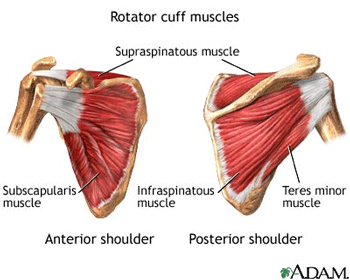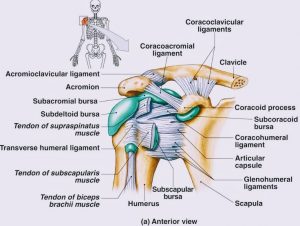May 8 2020
Shoulder pain is a common presentation that effects approximately 30% of the population. Some research suggests that up to 50% of people will have an episode of shoulder pain each year.
When shoulder pain strikes it can be very debilitating with it effecting everyday activities and sleep when it is at its worst.
Causes of shoulder pain are many and varied and finding the right solution can be challenging.
The following article will concentrate on the common presentation of rotator cuff tendinopathy.
As with many other conditions, there are a lot of names for all of the shoulder conditions that you can get and there is a huge amount of crossover. You may have been told you have;
Shoulder tendinitis, rotator cuff tendinitis, bursitis, rotator cuff tendinopathy, a supraspinatus tear … the list goes on!
Let’s try and clear some of this up …
SOME ANATOMY
The rotator cuff is a set of 4 muscles (supraspinatus, infraspinatus, teres minor, subscapularis) that help give your very mobile shoulder it’s stability. Pictured below, you can see that these muscles work together to help hold your shoulder stable whilst you move your arm for everything from daily activities to exercise.

Often pain arises when you overload your shoulder with a new or increased amount of exercise or activity. This can aggravate the tendon attachments in these muscles and cause pain. This can then cause you to change the way you use your shoulder and further irritate it via poor movement patterns.
THE DREADED BURSITIS
There are a number of shoulders in your bursa and we are sure you have had someone you know talk about having “bursitis” in their shoulder. The bursa, that are present around each synovial joint in your body, are a fluid sac that aim to decrease friction between bony and soft tissue structures that may rub against each other during movement. As you can see from the image below, there are a number of bursae in your shoulder. Commonly the subacromial bursa is the one that is most effected and is part of the pathological picture that presents with rotator cuff tendinopathy.

A WORD ON SCANNING
A lot of people will at some stage get some imaging on their shoulder due to the severe pain and functional loss that comes with shoulder pain. It is worth noting that on these scans there can be a lot of talk of “bursitis” and “inflammation” and “tendon tears” but this is not all doom and gloom. There is a lot of research suggesting that there are a lot of findings on these scans that can be a normal process of aging (damn!) and not a cause of pain. In a great study conducted in 2011, some researchers scanned the shoulders of people without any shoulder pain, between the ages of 40-70 and found 22% of them had rotator cuff tendon tears and 78% of them had some bursal thickening!
This shows us that a good treatment program is very effective for decreasing shoulder pain. In most cases this can be done without the need for invasive interventions.
SO WHAT DOES TREATMENT LOOK LIKE
As this is predominately a tendon problem, the principles of good tendon management apply. We did an article on these previously, click here to read that one.
Specifically for the shoulder treatment centres on trying to unload the shoulder from the painful activities or postures that are aggravating it. Physios will get a good understanding of what is causing your pain and suggest ways to do this.
Often some massage and manual therapy can help to ease the acute pain and then it is on to … your guessed it … EXERCISE!
Again, as with previous tendon management, the ai is to get the tendon and muscles firing again and build strength and capacity to tolerate the activity or sport that you are trying to do. This can begin with isometric exercises using small weights or theraband or even just the resistance of your own hand.
Exercises will then look to incorporate movement and do this in a more functional position that your shoulder gets into with your chosen activity.
As with other tendon problems, movement quality needs to be addressed for full rehabilitation. There are a number of factors that can influence this but in the shoulder stiffness in your thoracic spine (area where your ribs are) and poor control of your scapula (shoulder blade) with movement are two common presentations. Any issues here will be addressed as your strength progresses.
TIMELINES
If you haven’t guessed already, tendon problems take time. The shoulder is no different with 3 – 6 months of concerted effort needed to really get on top of the tough to treat presentations. At times, other treatments including anti -inflammatory medications or injections may help and be required in the process. Each presentation is different and your physio can help you decide when and where to proceed as you progress.
Hopefully this demystifies some of the complexity around shoulder pain that is related to the rotator cuff tendons. In essence, you have to slow it down to strengthen and then build it back up. It isn’t simple but it works. If you have a shoulder problem, we would love to help!



